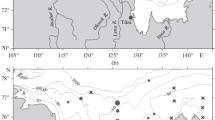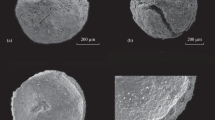Abstract
Biometrical investigations on coccoliths of the genusGephyrocapsa from the Neogene of the North-Atlantic were carried out using scanning-electron micrographs and yielded the following results: The different species ofGephyrocapsa are best distinguished from one another using the following morphological features coccolith-size, bridge-angle, roundness, and pore-width because these characteristics are not intercorrelated and can be easily measured. Tracing the development of these characteristics allows the reconstruction of the evolution ofGephyrocapsa in Pliocene and Quaternary periods and leads to a revision of this genus.
Earliest forms ofGephyrocapsa are found in theReticulofenestra pseudoumbilica Zone (NN 15) of the Early Pliocene. In the Late Pliocene three different evolutionary lines, i. e. groups of species, can be distinguished and subsequently followed until present time. At the base of the Pleistocene a fourth line branches off which evolves throughG. caribbeanica toG. oceanica and is significant for the nannoplankton zonation of the Quaternary.
Based on these biometrical investigations 11 species can be distinguished within the genusGephyrocapsa which only in part are identical with previous named species. Three new species had to be added.
Kurzfassung
Anhand raster-elektronenmikroskopischer Aufnahmen wurden biometrische Unter-suchungen an Coccolithen der GattungGephyrocapsa aus dem Neogen des N-Atlantiks durchgeführt und brachten folgende Ergebnisse: Zur Fassung und Abgrenzung vonGephyrocapsa-arten eignen sich vor allem die Merkmale Coccolithen-größe, BrÜckenwinkel, Rundung und Porenweite, die untereinander nicht korreliert sind und biometrisch leicht erfaßt werden können. Die Entwicklung dieser Merkmale erlaubt die Rekonstruktion derGephyrocapsa-Evolution im Pliozän und Quartär und eine systematische Revision dieser Gattung.
Erste Formen vonGephyrocapsa finden sich in derReticulofenestra pseudoumbilica-Zone (NN 15) des Unterpliozans. Seit dem Oberpliozän lassen sich innerhalb der Gattung drei getrennte Evolutionslinien (Artengruppen) unterscheiden, die bis in die Jetztzeit verfolgt werden kÖnnen. An der Pleistozän-Basis spaltet sich eine vierte Artengruppe ab, die sich überG. caribbeanica zuG. oceanica entwickelt und für die Nannoplankton-Zonierung des Quartärs von Bedeutung ist.
Aufgrund der biometrischen Untersuchungen können innerhalb der Gattung 11 Arten unterschieden werden, die mit den bisher aufgestellten, überwiegend typologisch gefaßten Arten nur zum Teil identisch sind. Drei Arten mußten neu aufgestellt werden.
Similar content being viewed by others
Literatur
Akers, H. W. &Koeppel, P. E. (1973): Age of some Neogene formations, Atlantic coastal plains, United States and Mexico. — Proc. Symp. Calc. Nannofossils, Gulf Coast Section S.E.P.M.: 80-93, Taf. 1–4; Houston.
Bartolini, C. (1970): Coccoliths from sediments of the western Mediterranean. — Micropaleontology,16: 129–154, Taf. 1-8, 8 Abb.; New York.
Breheret, J. (1978a): Formes nouvelles quaternaires et actuelles de la famille des Gephyrocapsaceae (Coccolithophorides). — C. R. Acad. Sci. Paris,287: Serie D: 447–449, 2 Taf.; Paris.
—— (1978b): Biostratigraphie du Pléistocène supérieur et de l’Holocéne de deux carottes de l’Atlantique Nord à l’aide des coccolithes. — C. R. Acad. Sci. Paris,287: Serie D: 599–601; Paris.
Boudreaux, J. E. &Hay, W. W. (1969): Calcareous nannoplankton and biostratigraphy of the late Pliocene-Pleistocene-Recent sediments in the Submarex cores. — Rev. Española Micropaleont.,1 (3): 249–292, Taf. 1-10, 1 Abb., 1 Tab.; Madrid.
Bukry, D. (1971): Coccolith stratigraphy Leg 6, Deep Sea Drilling Project. — Initial Reports Deep Sea Drilling Project,6: 965–1003, Taf. 1-8; Washington.
—— (1973): Coccolith stratigraphy, Eastern Equatorial Pacific, Leg 16 Deep Sea Drilling Project. — Initial Reports Deep Sea Drilling Project,16: 653–711, Taf. 1-5; Washington.
Cepek, P.;Johnson, D.;Krasheninnikov, V. &Pflaumann, U. (1977): Synthesis of the Leg 41 biostratigraphy and paleontology, Deep Sea Drilling Project. — Initial Reports Deep Sea Drilling Project,41: 1181–1198, 3 Abb.; Washington.
Cohen, C. L. D. (1964): Coccolithophorids from two Caribbean deep-sea cores. — Micropaleontology,10: 231–250, 6 Taf.; New York.
Deflandre, G. &Fert, C. (1954): Observations sur les coccolithophoridés actuels et fossiles en microscopie ordinaire et électronique. — Ann. Paléont.,40: 117–176, 15 Taf., 117 Abb.; Paris.
Ericson, D. B. &Wollin, G. (1968): Pleistocene climates and chronology in deep-sea sediments. — Science,162: 1227–1234; Washington.
Gartner, S., Jr. (1969): Correlation of Neogene planktonic foraminifera and calcareous nannofossil zones. — Transact. Gulf Coast Assoc. Geol. Soc.,19: 585–599, Taf. 1-2, 7 Abb.
—— (1972): Late Pleistocene calcareous nannofossils in the Caribbean and their interoceanic correlation. — Paleogeography, Paleoclimatology, Paleoecology,12: 169–191, Taf. 1-2; Amsterdam.
—— (1977): Calcareous nannofossil biostratigraphy and revised zonation of the Pleistocene. — Marine Micropaleontology,2: 1–25, Taf. 1-4; Amsterdam.
Geitzenauer, K. R. (1972): The Pleistocene calcareous nannoplankton of the subantarctic Pacific Ocean. — Deep-Sea Research19: 45–60, Fig. 1-2; Oxford.
Halldal, P. &Markali, J. (1955): Electron microscope studies on coccolithophorids from the Norwegian Sea, the Gulf Stream, and the Mediterranean. — Avh. Norsk. Vidensk.-Akad. Oslo, Mat.-Naturvidensk. Kl.,1: 1–30, 27 Taf.; Oslo.
Haq, B. U.;Berggren, W. A. &van Couvering, J. A. (1977): Corrected age of the Pliocene/Pleistocene boundary. — Nature269: 483–488, 5 Abb.
Hay, W. W. &Beaudry, F. M. (1973): Calcareous nannofossils — Leg 15, Deep Sea Drilling Project. — Initial Reports Deep Sea Drilling Project15: 625–683, 1 Taf.; Washington.
Hay, W. W.;Mohler, H. P.;Roth, P. H.;Schmidt, R. R. &Boudreaux, J. E. (1967): Calcareous nannoplankton zonation of the Cenozoic of the Gulf Coast and Caribbean-Antillean area, and transoceanic correlation. — Transact. Gulf Coast Assoc. Geol. Soc.17: 428–480, 13 Taf., 13 Abb.
Heimdal, B. R. (1973): Two new taxa of Recent Coccolithophorids. — »Meteor«-Forsch.-Ergebnisse, D,13: 70–75, Abb. 1-8; Berlin-Stuttgart.
Kamptner, E. (1943): Zur Revision der Coccolithineen-SpeziesPontosphaera huxleyi Lohm. — Anz. Akad. Wiss. Wien, Math.-Naturw. Kl.,80 (11): 43–49; Wien.
—— (1956): Das Kalkskelett vonCoccolithus Huxleyi (Lohm.) Kpt. undGephyrocapsa oceanica Kpt. (Coccolithineae). — Arch. Protistenk.101: 171–202, Taf. 16.
—— (1963): Coccolithineen-Skelettreste aus Tiefseeablagerungen des Pazifischen Ozeans. — Ann. Naturhist. Mus. Wien,66: 139–204, Taf. 1-9, Abb. 1-39; Wien.
Lecal, J. (1967): Le Nannoplancton des côtes d’Israël. — Hydrobiologia,29: 322–323, Abb. 16-17, Fig. 23-24.
Martini, E. (1971): Standard Tertiary and Quaternary calcareous nannoplankton zonation. — In:Fari-nacci, A. (Hrsg.): Proc. 2nd Plankt. Conf. Roma2: 739-785; Edizioni Tecnoscienza Rom.
Martini, E. &Worsley, T. (1970): Standard Neogene calcareous nannoplankton zonation. — Nature,225: 289–290.
McIntyre, A. (1967): Coccoliths as paleoclimatic indicators of Pleistocene glaciation. — Science,158: 1314–1317.
—— (1970):Gephyrocapsaprotohuxleyi sp. n., a possible phyletic link and index fossil for the Pleistocene. — Deep-Sea Research,17: 187–190, 1 Abb., Oxford.
McIntyre, A. &Be, A. W. H. (1967): Modern Coccolithophoridae of the Atlantic Ocean. I. Placoliths and Cyrtoliths. — Deep-Sea Research,14: 561–597, 12 Taf., 17 Abb., Oxford.
McIntyre, A.;Be, A. W. H. &Preikstas, R. (1967): Coccoliths and the Pliocene-Pleistocene boundary. — Progr. in Oceanography,4: 3–25, Taf. 1-6.
McIntyre, A.;Be, A. W. H. &Roche, M. B. (1970): Modern Pacific Coccolithophorida: A Paleontological Thermometer. — Trans. N.Y. Acad. Sci., Ser. II,32: 720–731, 9 Abb.; New York.
McIntyre, A.;Ruddiman, W. F. &Jantzen, R. (1972): Southward penetrations of the North Atlantic polar front: faunal and floral evidence of large-scale surface water mass movements over the last 225 000 years. — Deep-Sea Research,19: 61–77, Abb. 1-8; Oxford.
Müller, C. (1976): Tertiary and Quaternary calcareous nannoplankton in the Norwegian-Greenland Sea, DSDP, Leg 38. — Initial Reports Deep Sea Drilling Project,38: 823–841, Taf. 1; Washington.
Nishida, S. (1970): Nannoplankton from the deep-sea ooze of the equatorial Pacific. — Trans. Proc. Paleont. Soc. Japan, N. S.,79: 355–370, Taf. 39-41, 2 Abb.
Okada, H. &Honjo, S. (1970): Coccolithophoridae distributed in Southwest Pacific. — Pacific Geol.2: 11–21, Taf. 1-3.
Okada, H. &McIntyre, A. (1977): Modern coccolithophores of the Pacific and North Atlantic Ocean. — Micropaleontology,23: 1–55, Taf. 1-13; New York.
Percival, St. F., Jr. (1978): Indigenous and reworked coccoliths from the Black Sea. — Initial Reports Deep Sea Drilling Project,52: 773–781, Taf. 1; Washington.
Roth, P. H. (1974): Calcareous nannofossils from the northwestern Indian Ocean, Leg 24, Deep Sea Drilling Project. — Initial Reports Deep Sea Drilling Project,24: 969–994, 4 Abb.; Washington.
Sachs, J. B. &Skinner, H. C. (1973): Late Pliocene — early Pleistocene Nannofossil stratigraphy in the north central Gulf Coast area. — Proc. Symp. Calc. Nannofossils, Gulf Coast Section S. E. P. M.: 94-125, Taf. 1–6; Houston.
Samtleben, C. (1978): Pliocene-Pleistocene Coccolith Assemblages from the Sierra Leone Rise-Site 366, Leg 41. — Initial Reports Deep Sea Drilling Project,41 (Suppl.): 913–931, Taf. 1-5; Washington.
Thierstein, H. R.;Geitzenauer, K. R.;Molfino, B. &Shackleton, N. J. (1977): Global synchroneity of late Quaternary coccolith datum levels: Validation by oxygen isotopes. — Geology,5: 400–404.
Winter, A.;Reiss, Z. &Luz, B. (1978): LivingGephyrocapsa protohuxleyi McIntyre in the Gulf of Elat (’Aqaba). — Marine Micropaleontology,3: 295–298, Taf. 1; Amsterdam.
Author information
Authors and Affiliations
Rights and permissions
About this article
Cite this article
Samtleben, C. Die Evolution der Coccolithophoriden-GattungGephyrocapsa nach Befunden im Atlantik. Paläont. Z. 54, 91–127 (1980). https://doi.org/10.1007/BF02985885
Issue Date:
DOI: https://doi.org/10.1007/BF02985885




